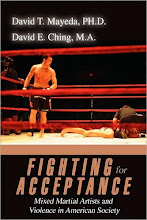 Article cross-posted at BloodyElbow.com
Article cross-posted at BloodyElbow.comIntroduction
Since World War II, the face of American big business has changed dramatically. In the 1950s and ‘60s, chief executive officers of successful companies obviously made substantially more than their employees. At that time, CEOs made roughly 25 to 30 times what their average employee made. In the 1980s, big business practices changed. Factories were being moved overseas to capitalize on cheaper labor sources while government under the Reagan Administration infringed less and less on big business practices.
In 1980, the CEO of a major company made about 40 times that of an average employee. By 1990, the ratio rose to 100 times. In 2007, a typical CEO of a major company made 350 times the average company worker. Wal-Mart exemplifies this shifting trend in business relationships vividly. It was the largest U.S. company in 2005, and at that time, Wal-Mart’s CEO made 900 times that of the average Wal-Mart worker (Pickett & Wilkinson, 2011).
Forty, fifty years ago, CEOs were more compelled to maintain positive relationships with their employees and adhere to tighter governmental oversights. Employees also had stronger collective bargaining rights and better relationships with management. Today, management and owners maintain distance from employees through protective legal mechanisms and worker disposability that together, limit workers’ efforts to unite in fighting for fair pay, health care, retirement, education, and other potential benefits.
So what does all this have to do with mixed martial arts?
In 2001, Frank and Lorenzo Fertitta paid $2 million to purchase the Ultimate Fighting Championship (UFC). It is common knowledge that the two brothers lost $44 million in their UFC investment from 2001 to 2004. But in April 2008, Forbes magazine reported that the UFC had skyrocketed in value to $1 billion. Assuming these figures are correct, then in seven years the UFC’s value increased nearly 50,000%. No, that is not a typo.
As stated from the 2008 Forbes article:
The majority of UFC revenues come from the monthly pay-per-view events. Additional cash is made from ticket sales to live fights and licensing fees from its Spike cable shows The Ultimate Fighter and UFC Fight Night. These shows in turn act as promotional tools to drive fans to pay-per-view events. More scratch comes from sales of DVDs and T shirts, as well as downloads from UFC’s library of past bouts.
In 2008, the UFC “generated a over a quarter of a billion dollars in business in gate receipts, UFC merchandise, and licensing fees” (Lim et al., 2010, p. 50).
At present it is difficult to say how much the Fertitta brothers make specifically from the UFC on an annual basis. For what it is worth, “Celebrity Net Worth” currently lists Lorenzo Fertitta's net value at $1 billion, though this would stem from much more than the UFC. And while the Fertitta brothers each own 45% of the UFC, the remaining 10% is owned by the company’s President and public face, Dana White, who is reportedly worth approximately $150 million.
Again, it is difficult, possibly impossible, to know what the three UFC owners make on an annual basis, or what percentage they each net from the UFC’s various revenue sources. But it is probably safe to say, they are making a substantial amount. Many would argue they deserve it – they had the vision and took the risks to build the UFC. They have persevered and profited under the capitalist system.
And so have some of their workers…
As noted in the prior piece in this series of essays, Georges St. Pierre made $8,000 in a winning effort at UFC 48; today a GSP win yields the current welterweight champ $400,000 – a 4,900% increase. Back in 2007 when Rashad Evans fought Tito Ortiz to a draw, he made $16,000; more recently after defeating “Rampage” Jackson, Evans was rewarded with $435,000 – a 2,618% increase. Clearly, as a UFC fighter’s star power rises, so can his salary. However, this is not necessarily the optimal way to analyze UFC fighters’ salaries over time.
Methodology
A more detailed description of the methods for this piece can be found here. In short, to collect data for this project, the available information was gathered from MMA websites for each fighter's publicly stated earned income from UFC 100 to UFC 127. Only major fight cards were examined for this project, essentially meaning cards that were held on a pay-per-view basis.
For this sample, a total of 15 fight cards were examined, in which 326 payouts (also known as a fighter's "purse") were made to fighters; fighter salaries for 13 UFC fight cards during this timeframe could not be located. These payouts will be referred to as the “Post-UFC Boom Payouts.” Additionally for comparative purposes, 100 payouts were examined from UFC 44, UFC 46, UFC 47, UFC 48, UFC 49, and UFC 51, fight cards that took place from 2003 to 2005, just before the UFC turned the corner and began making major profits. Data for these earlier payouts were gathered from a blog managed by Ivan Trembow (here, here, and here). These payouts will be referred to as the “Pre-UFC Boom Payouts.”
There are a few important limitations to these methods. First, the public compensation made to fighters within the UFC promotion does not include "backstage/locker room" bonuses that are given to select fighters by management (as noted by commenters in the first article using this data set). Nor does the data set include possible royalties that elite fighters may secure from pay-per-view buys, DVD sales, etc. (which would expand the stratification among fighters since middle and lower-tier fighters would likely not secure such compensation).
Findings and Discussion
Pre-UFC Boom Payouts (N = 100):
• Mean: $29,180
• Median: $8,000 (best measure)
• Standard deviation: $46,726
Post-UFC Boom Payouts (N = 326):
• Mean: $66,012
• Median: $27,000 (best measure)
• Standard deviation: $92,164
It is worth reiterating that the standard deviation (general dispersion from the mean) in both these cases is extremely large, demonstrating the massive inequality in payouts among fighters. Furthermore, the standard deviation has expanded substantially over time, nearly doubling from the pre-boom to post-boom years, which is attributed heavily to pay increases among the UFC’s top stars, coupled with very modest increases for prelim fighters.
A comparison of the means is statistically significant at .001, indicating a highly significant boost in fighters’ average pay over the years. However, the best measure when examining average income is the median, and clearly the median pay for UFC fighters has risen substantially, up from $8,000 in the pre-boom years to $27,000 in the post-boom years, a 237% increase.
The pay distribution between the two samples was also made, dividing each sample into rough quartiles:
Pre-UFC Boom:
* Highest paid 25%: $30,000-$225,000 (n=25)
* 2nd highest paid 25%: $10,000-$23,000 (n=19)
* 3rd highest paid 25%: $5,000-$8,000 (n=26)
* Lowest paid 25%: $2,000-$4,000 (n=30)
Post-UFC Boom:
* Highest paid 25%: $83,000-$500,000 (n=82)
* 2nd highest paid 25%: $27,000-$81,000 (n=82)
* 3rd highest paid 25%: $13,000-$26,000 (n=78)
* Lowest paid 25%: $3,000-$12,000 (n=84)
As would be expected, within each quartile fighters make considerably more in the post-UFC boom years. The top earner in the pre-UFC boom sample was Randy Couture, who earned $225,000 ($150,000 to show; $75,000 to win) at UFC 49. Couture’s top earnings at UFC 49 were less than half of what Chuck Liddell and James Toney made ($500,000) in losing efforts at UFC 118 and 115, respectively.
But even in the earlier UFC sample, status was a critical factor that increased fighter pay. Tito Ortiz earned three out of the top ten purses in the “pre-boom” sample, losing twice and both times earning $125,000. Within the lower quartile of the earlier sample, a few fighters were represented who still compete now and have heavily improved their name recognition (e.g., Chris Lytle, Josh Thompson, Jorge Rivera, Nick Diaz). However, most fighters in the lower quartile have not been active in the UFC the past two years.
The decreased activity of many fighters in the lowest quartile of the “pre- boom” sample is significant because it could suggest what will occur among the larger number of lower-tier fighters on the current UFC roster. As the global market of fighters expands, the lower-tier fighters become more expendable. Their work status is increasingly precarious in an occupation that is already erratic due to the sport’s highly physical nature.
In fact, looking at the lowest quartile of the “pre-boom” era, there were 27 fighters represented (for 30 payouts). Of these 27 fighters, only 8 had competed in the UFC in the last two years (roughly 30%), though a few of these fighters who had not recently competed in the UFC were competing in high profile matches elsewhere (e.g., Nick Diaz). Most fighters in the lower quartile remained active; 21 out of 27 had fought in either the UFC or another organization within the last 2 years, while 9 had not competed at all since April 2009.
This may not be terribly surprising – these are typically the UFC prelim fighters getting a first or second opportunity on a UFC pay-per-view card, or the aging veterans lucky enough to be given an extra chance. As time goes by, the less talented pool fades out. Under the fight game’s structure, they are replaced by younger, more talented prospects. And the callous, business-oriented perspective argues high monetary compensation is not these lower-tier fighters’ reward. Rather, they were given the opportunity, and they washed out of the sport's top organization.
For all the rhetoric among some fans and pundits who suggest fighters should be grateful for simply having an opportunity with the UFC, critics must also consider an average pro-MMA fighter’s “fighting life.” If fighting and training others is a full time job, this leaves minimal time for developing additional occupational skills, despite the fact that virtually all fighters will have a significant amount of years to live after their professional fight skills have diminished.
Although fighter purses have risen substantially, their growth is hardly commensurate with the UFC’s increased value during the same general timeframe. As one BloodyElbow commenter stated in response to lower-tier fighters’ precarious position in the UFC:
Another thing is that over time, although fighter pay has steadily increased, the amount of money the UFC makes has risen enormously. The fighter’s piece of the pie has become much smaller, and therein lies the issue. If you kept the percentage of revenue allocated towards fighter’s pay the same as it was a few years ago, then the stars would be making true star money, and the lower level guys would be making more than 3 grand a fight. That’s where the REAL money is, not in the “_ of the Night” bonuses.
Thus, when Randy Couture discusses a fighters’ union, health insurance, retirement plans, and education, people should listen and do so seriously. For health insurance, fighters are covered for injuries that happen in the Octagon on fight night only. Is it completely implausible to make health insurance available once a fight contract is signed, at which time the fighter is training specifically for a UFC fight card? Additionally, more substantial increases for fighters’ purses – at all levels, but especially the lower levels – are warranted. The UFC has grown immensely, and for that, many people are grateful, including many fans. Why not raise the fighters’ compensation at a more proportionate rate? Ultimately, they are the reason fans keep coming to watch.
Non-internet References:
Lim, C. H., Martin, T. G., & Kwak, D. H. (2010). Examining television consumers of mixed martial arts: the relationship among risk taking, emotion, attitude, and actual sport-media-consumption behavior. International Journal of Sport Communication, 3, 49-63.
Pickett, K., & Wilkinson, R. (2011). Preface to The Spirit Level: Why Greater Equality makes Societies Stronger by Robert Reich. New York: Bloomsbury Press.

academics blogs








No comments:
Post a Comment